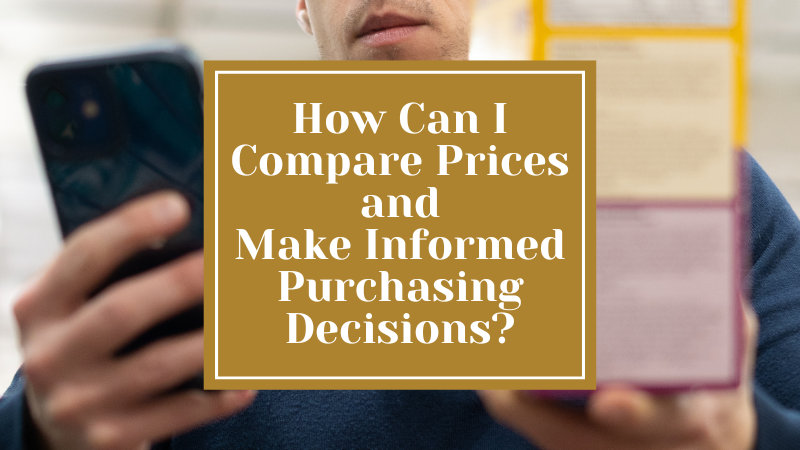Once upon a time, there was a savvy shopper named Sarah who was in the market for a new laptop. She had her eye on a particular model that she had seen advertised at a local electronics store. Excited about the prospect of getting a new laptop, she decided to head straight to the store and make the purchase.
However, just before leaving her house, Sarah had a thought: “Wait a minute! I should check online to see if I can find a better deal.” So, she took a few minutes to compare prices across different online retailers.
To her surprise, Sarah discovered that the same laptop was available at a significantly lower price on a reputable online marketplace. The price difference was substantial, and it made her realize that a few moments of comparison saved her a significant amount of money.
Eager to make the most of her savings, Sarah decided to order the laptop online. Not only did she get a great deal, but the laptop arrived in perfect condition, exceeding her expectations.
This anecdote highlights how taking the time to compare prices can lead to substantial savings. By exploring different options and considering alternative sellers or platforms, Sarah was able to make an informed purchasing decision and save a significant amount of money.
The moral of the story is that even a simple comparison of prices can make a big difference in your wallet. Whether it’s electronics, clothing, or household items, always remember to compare prices before making a purchase. You never know how much you could save with just a little extra effort and research!
You May Also Like: How Can I Save Money While Shopping for Groceries?
How to Compare Prices to Make Informed Purchasing Decisions
Comparing prices and making informed purchasing decisions is crucial to ensure you get the best value for your money. No one likes that icky feeling you get when you make a larger purchase and then realize you could have saved tons of money by shopping around, waiting for a sale, or using a coupon.
Here are some tips to help you compare prices to ensure you get the best price the first time:
1. Research and Compare Prices Online
Researching and comparing prices online can be a valuable strategy to ensure you’re getting the best deal. To begin, start by identifying the specific product you want to purchase. Use search engines or visit trusted online marketplaces and retailer websites to gather a list of potential sellers. Take note of the prices listed for the item across different platforms.
Next, delve deeper into each seller’s website or product listing. Look for detailed product descriptions, specifications, and customer reviews to gain a better understanding of the quality and features of the item. Pay attention to any additional costs, such as shipping fees or taxes, as these can impact the overall price.
Utilize price comparison websites or browser extensions designed to aggregate prices from various online retailers. These tools provide a convenient way to compare prices side by side, helping you identify the lowest price available.
Additionally, consider checking out online forums or social media groups where users share their experiences and recommendations regarding specific products or deals they’ve found.
2. Check for Discounts and Promotions
While comparing prices, keep an eye out for discounts, promotions, or coupon codes that can further reduce the price. Many retailers offer exclusive deals or loyalty programs that can result in additional savings. I often try searching the company name + coupon, the product name + coupon, and, if I still haven’t found anything, I search for reviews to see if any influencers have codes for the item.
Take advantage of price alerts or sign up for newsletters to stay informed about special offers and sales for big ticket items as well.
3. Compare Beyond the Price
When comparing prices, it’s essential to take into account factors beyond the cost. Consider the reputation and reliability of the seller, their return policy, warranty or guarantee terms, and customer service ratings. These aspects can greatly impact your overall purchasing experience and satisfaction with the product.
Nothing sucks more than purchasing an expensive item that ends up being defective and realizing that the company is very hard to work with, refuses refunds, or expects you to pay high shipping or restocking fees in order to get another product.
Take into account the reputation and reliability of the brand you’re considering. Brands known for their quality and customer satisfaction may be worth paying a bit more for, as they often provide better product performance and customer support.
4. Image Search Furniture and Hard to Find Items
Some products, like furniture, are hard to compare prices on because retailers will use many different names for the exact same items. Higher-end retailers will have much higher markups than lower end ones.
I love browsing high-end and luxury furniture stores to find furniture for my house, but I never pay their prices. Instead, I image search the pieces I like and see if I can find it somewhere else. I almost always have and once I even save over $600 dollars on a item just by doing a quick image search.
Check out this article for more details on how to save money when shopping for furniture.
5. Read Customer Reviews
Customer reviews can provide valuable insights into the quality, durability, and performance of a product. They also often mention things about price as well, such as, “I got this on sale for X” or “I like this product, but it’s not worth it anymore since they raised the price.”
I also always check the negative reviews. While many companies take time to get curated 5-star reviews that you can’t always trust, negative reviews are almost always from actual customers. I always read negative reviews and look for trends. Are multiple people saying the exact same thing about the product? Then it’s probably a trend and I should perhaps look for an alternative.
Consider reading reviews from multiple sources to get a well-rounded understanding of the product you’re interested in.
6. Consider Necessity of Features and Specifications
Look beyond the price and compare the features and specifications of the products you’re considering. Determine which features are essential to you and compare them across different brands or models.
Do you really need a million gigabytes of storage or are you fine with another model with just a couple? Do you really need all the features of the most expensive top-of-the-line product? Or will you end up ignoring them and would be just as happy with a cheaper option that lacks some of them.
It’s easy to get caught up in marketing that’s designed to make us think we need the biggest and the best of everything, but over the years I’ve found that many of these life-chanigng features end up being ignore. Really take a few minutes to decide if the features you’re buying are ones you’ll actually use.
7. Consider Long-Term Costs and Costs of Ownership
While upfront prices are important, also consider the long-term costs associated with the product. For example, if you’re buying an appliance, consider factors like energy efficiency and maintenance costs, as they can impact your expenses in the long run.
Think about the cost to buy filters, cleaner, kerig cups, etc. Is their recurring maintenance that is meant to be done? Insurance? Are you financing a larger appliance and will end up paying more in interest? These costs can add up and the cheapest options isn’t always going to be the cheapest option long term. sometimes a slightly higher upfront cost can be offset by lower long-term expenses.
Check reviews to see if there are comments about the product breaking down a lot, having overly expensive filters or replacement costs, or other hidden costs of ownership.
8. Look for Warranties or Guarantees
Check if the product comes with a warranty or guarantee. Understanding the warranty terms can help you assess the value and reliability of the product. Plus, it can be reasurring to know that you’re protected if something goes wrong and won’t end up out your money and the product.
9. Take Advantage of Price Matching Policies
Some retailers offer price matching policies where they match the price of a competitor if you find the same product at a lower price elsewhere. This can help you secure the best price while still being able to enjoy the convience of picking something up that day.
10. Keep an Eye Out For Sales or Discounts and Look into Price Protection
Oftentimes, if you make a purchase and then see that item go on sale shortly after, you can get a refund for the difference. Stores will typically rather refund you the difference then have you return an item in order to purchase it again for the cheaper price.
Some credit cards or retailers also offer price protection policies, which can reimburse you the difference if the price of a purchased item drops within a specified time frame. Check if your credit card or preferred retailer provides this feature.
11. Plan Your Purchases
Avoid impulsive buying by planning your purchases in advance. Create a budget and prioritize your needs, allowing you to make more informed decisions based on your financial situation and priorities.
In addition, while everyone knows about when obvious sales will happen like on seasonal clothing or holiday decor, they don’t alwas realize that almost all retail categories have sale periods. Do a quick search for the type of items you’re looking for to figure out when they’re known for going on sale.
12. Go Directly to the Source
Sometimes, if you go a brand’s site over a retailer site that carries that brand, you may find that the brand is able to offer the item at a cheaper cost or with a steeper discount than the retailer is able to since you are essentially cutting out the middle man.
13. Look for Package Deals or Bundled Offers
Some retailers offer package deals or bundled offers where you can get multiple items or services together at a discounted price. Assess if these bundles align with your needs and provide better value compared to purchasing individual items separately.
14. Utilize Price Tracking Tools
Price tracking tools or apps can help you monitor price fluctuations for specific products over time. They can notify you when the price drops or reaches a desired threshold, allowing you to make a purchase at the most opportune moment.
Some popular price tracking tools and apps are Honey, CamelCamelCamel, Price Grabber, ShopSavvy, Google Shopping, PRice Runner, and More.
15. Take Advantage of Rewards Programs
Many retailers offer rewards programs or loyalty cards that can provide additional discounts, exclusive offers, or cashback rewards. Sign up for these programs to maximize your savings.
16. Consider Alternative Brands or Generic Options
Don’t overlook alternative brands or generic products that can often offer similar quality at a lower price compared to well-known brands. Read reviews and do your research to ensure they meet your requirements. Sometimes people will also leave reviews on the higher end brands about a cheaper alternative they love just as much if not more.
17. Seek Recommendations and Advice
Reach out to friends, family, or online communities for recommendations and advice on products you’re interested in. They may have personal experiences or insights that can help inform your decision-making process.
18. Check for Product Recalls or Safety Issues
Before purchasing a product, check if there have been any product recalls or safety issues associated with it. This information can be found on official consumer safety websites or through product recall databases.
19. Consider Long-Term Sustainability
If sustainability is important to you, consider the environmental impact and sustainability practices of the product and the brand behind it. Look for certifications or labels indicating eco-friendly or sustainable manufacturing processes.
20. Subscribe to Newsletters and Loyalty Programs
Sign up for newsletters or loyalty programs offered by retailers. They often provide exclusive discounts, early access to sales, or special offers that can help you save money.
Plus, they send them directly to you so that you don’t have to constantly be on the lookout for when the sale happens.
21. Utilize Social Media Platforms
Follow your favorite brands or retailers on social media platforms. They may share exclusive promotions or discounts with their followers, giving you the opportunity to snag a deal.
22. Attend Trade Shows or Exhibitions
Trade shows or exhibitions often feature multiple vendors and brands showcasing their products. This provides an opportunity to compare prices, learn about new products, and negotiate deals in person.
Remember to approach price comparison with a balanced perspective, considering factors beyond just the price itself. Assess the overall value, quality, and suitability of the product, as well as your budget and personal preferences, to make the most informed purchasing decisions.
Draw Backs to Price Checking and Comparison Shopping
While price checking can be beneficial, it also has some potential drawbacks to be aware of. Everyone knows that price checking can save you money, but I see a lot of emphasis being put on price checking like it’s a fix all for all of your money and shopping woes.
However, putting too much empashsis on price comparing isnt always good. here are some potential draw backs of it:
- Time and effort: Conducting thorough price checks requires time and effort. It involves researching different sellers, comparing prices across multiple platforms, and analyzing various factors. For some individuals, the time investment may outweigh the potential savings, particularly for smaller or everyday purchases.
- Overemphasis on price: Focusing solely on price may lead to overlooking other important factors, such as quality, customer service, or product features. Sometimes a slightly higher-priced item offers better value in terms of durability, performance, or long-term satisfaction. It’s essential to strike a balance between price and quality to ensure you’re getting the best overall value.
- Inconsistent pricing: Prices can fluctuate frequently, especially in online marketplaces where dynamic pricing algorithms are used. The price you see today may not be the same tomorrow. This can make it challenging to accurately compare prices over time, particularly for non-essential or non-urgent purchases.
- Limited information: Price comparison tools and websites provide valuable insights, but they may not always capture the complete picture. They might not account for localized deals, in-store promotions, or exclusive discounts. It’s important to consider multiple sources and check for any additional savings or offers that may not be reflected in the price comparison results.
- Buying paralysis: The process of price checking can sometimes lead to analysis paralysis or indecision. Constantly comparing prices and seeking the best deal may cause hesitation and missed opportunities. It’s important to strike a balance and recognize when the time and effort invested in price checking outweigh the potential savings.
By being aware of these drawbacks, you can make a more informed decision about when to prioritize price checking and when it may not be worth the effort. It’s essential to consider your specific needs, the nature of the purchase, and the potential trade-offs involved.
Times When It’s Worth Comparing Prices and Times When it Might Not Be Worth It
Price-checking can be beneficial in various scenarios, but it’s important to consider the context and value of the item you’re purchasing. Depending on your situation, your time may be more valuable than the time it takes to go through these price checking steps.
Here are a few instances when price-checking is particularly worthwhile:
- Big-ticket items: When making significant purchases like electronics, appliances, or furniture, it’s worth the effort to compare prices across different retailers. The potential savings can be substantial, making price-checking essential.
- Recurring expenses: For ongoing expenses like insurance premiums, utility bills, household items you buy often, or subscription services, regularly reviewing and comparing prices can help you find better deals or identify opportunities to negotiate lower rates.
- Travel and accommodation: When planning vacations or booking accommodations, comparing prices across different travel websites, airlines, or hotel platforms can help you find the best deals and potentially save a significant amount of money.
On the other hand, there are situations when price-checking may not be as crucial:
- Low-cost, home items: For inexpensive items or home necessities with minimal price variations, the time and effort spent on price-checking may not yield substantial savings. In these cases, focusing on convenience and personal preferences may take priority over price comparisons.
- Low-cost, one time purchases: Have a birthday party coming up? Need a odd one-time item for an activity? These are times when it’s probably not really going to be worth price checking every toy in the store to see if you can get it cheaper somewhere else. It’s probably easiest to just grab something you like and go in these cases.
Ultimately, the decision to price-check depends on the potential savings, the significance of the purchase, and the amount of time and effort required. Assessing the value and considering your personal priorities will help you determine when it’s worth investing the time to compare prices and when it may not be as essential.




